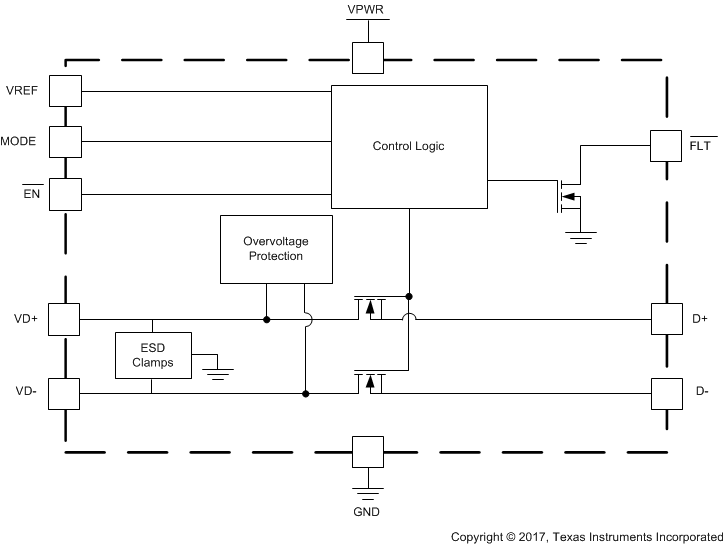ZHCSGF6A April 2017 – July 2017 TPD2S701-Q1
PRODUCTION DATA.
- 1 特性
- 2 应用
- 3 说明
- 4 修订历史
- 5 Pin Configuration and Functions
-
6 Specifications
- 6.1 Absolute Maximum Ratings
- 6.2 ESD Ratings—AEC Specification
- 6.3 ESD Ratings—IEC Specification
- 6.4 ESD Ratings—ISO Specification
- 6.5 Recommended Operating Conditions
- 6.6 Thermal Information
- 6.7 Electrical Characteristics
- 6.8 Power Supply and Supply Current Consumption Chracteristics
- 6.9 Timing Requirements
- 6.10 Typical Characteristics
- 7 Parameter Measurement Information
- 8 Detailed Description
- 9 Application and Implementation
- 10Power Supply Recommendations
- 11Layout
- 12器件和文档支持
- 13机械、封装和可订购信息
1 特性
- 符合 AEC-Q100 标准
- –40°C 至 125°C 的工作温度范围
- VD+ 和 VD– 上的 VBUS 短路保护
- ESD 性能 VD+,VD–
- ±8kV 接触放电(IEC 61000-4-2 和 ISO 10605 330pF,330Ω)
- ±15kV 气隙放电(IEC 61000-4-2 和 ISO 10605 330pF,330Ω)
- 高速数据开关(1GHz 带宽)
- 只需要 5V 电源
- 可调节 OVP 阈值
- 快速过压响应时间(典型值 200ns)
- 热关断特性
- 集成输入使能和故障输出信号
- 保证数据完整性的直通路由
- 10 引脚 VSSOP 封装 (3mm × 3mm)
- 10 引脚 QFN 封装 (2.5mm × 2.5mm)
2 应用
- 终端设备
- 音响主机
- 后座娱乐系统
- 远程信息处理
- USB 集线器
- 导航模块
- 媒体接口
- 接口
- USB 2.0
- USB 3.0
3 说明
TPD2S701-Q1 是一款用于汽车高速接口(如 USB 2.0)的双通道线路 VBUS 短路和 IEC61000-4-2 ESD 保护器件。TPD2S701-Q1 包含两个数据线路 nFET 开关。这些开关通过提供业界一流的带宽,实现最小的信号衰减,同时可保护内部系统电路(在 VD+ 和 VD– 引脚上),使其免受过压情况的损坏,从而确保安全的数据通信。
在这些引脚上,此器件可实现直流电高达 7V 的过压保护。这为 USB VBUS 轨的数据线路短路提供了充分保护。该过压保护电路提供业界最可靠的 VBUS 短路隔离,能在 200ns 内关闭数据开关,并保护上游电路免受有害电压和电流尖峰影响。
此外,TPD2S701-Q1 只需要 5V 的单一电源,这优化了电源树的大小和成本。该器件允许通过电阻分压器网络调整 OVP 阈值和钳位电路,为优化系统保护提供了一种简单且经济高效的方法(适用于任何收发器)。TPD2S701-Q1 还包括一个 FLT 引脚,该引脚会在器件出现过压状况时发出指示,并在过压状况消除后自动复位。
TPD2S701-Q1 还在 VD+ 和 VD– 引脚上集成了系统级别的 IEC 61000-4-2 和 ISO 10605 ESD 钳位,因此在应用中无需再配置高压、低电容的外部 TVS 钳位电路。
器件信息(1)
| 器件型号 | 封装 | 封装尺寸(标称值) |
|---|---|---|
| TPD2S701-Q1 | VSSOP (10) | 3.00mm × 3.00mm |
| QFN (10) | 2.50mm x 2.50mm |
- 要了解所有可用封装,请参见产品说明书末尾的可订购产品附录。
功能框图
